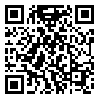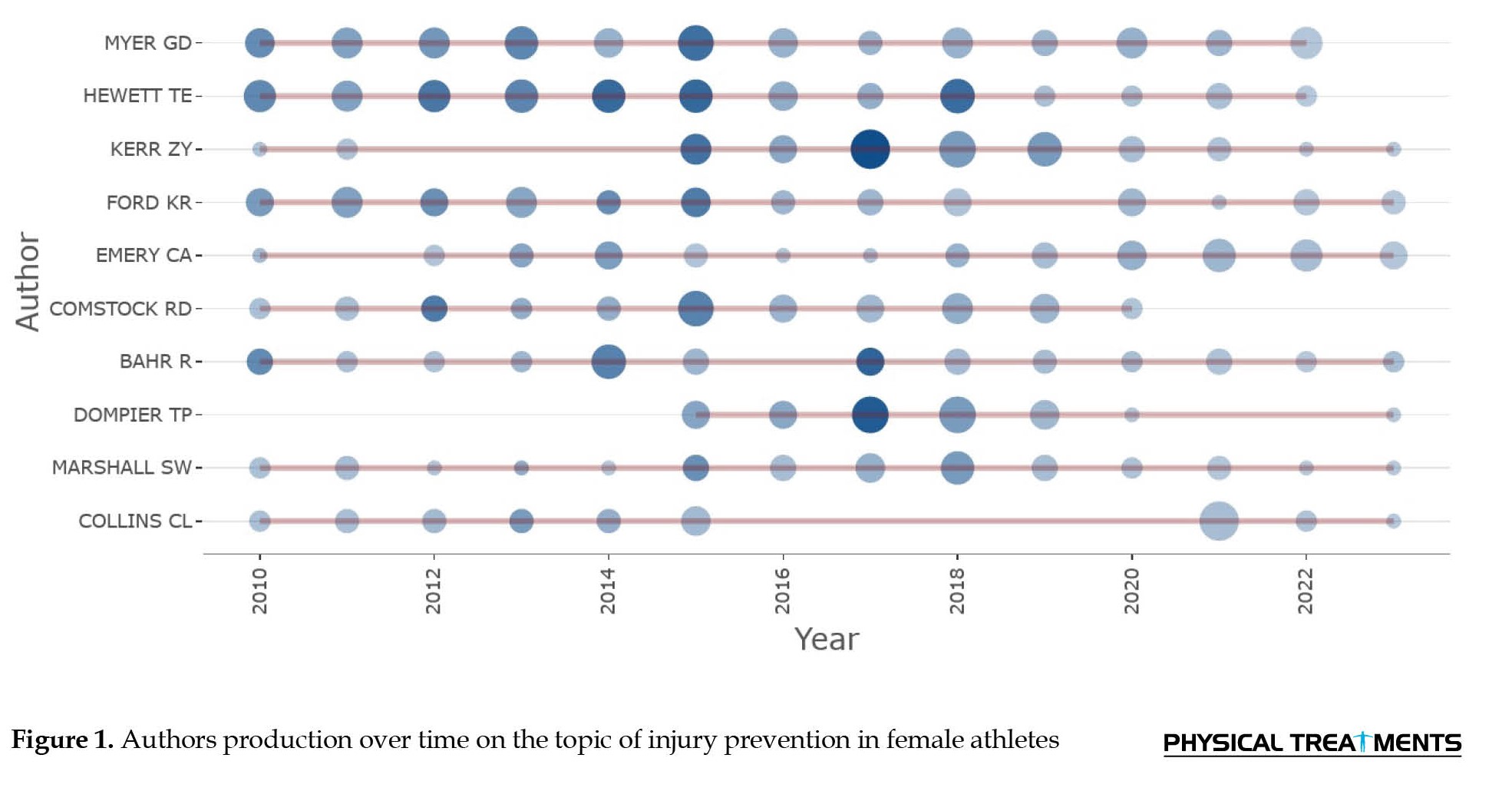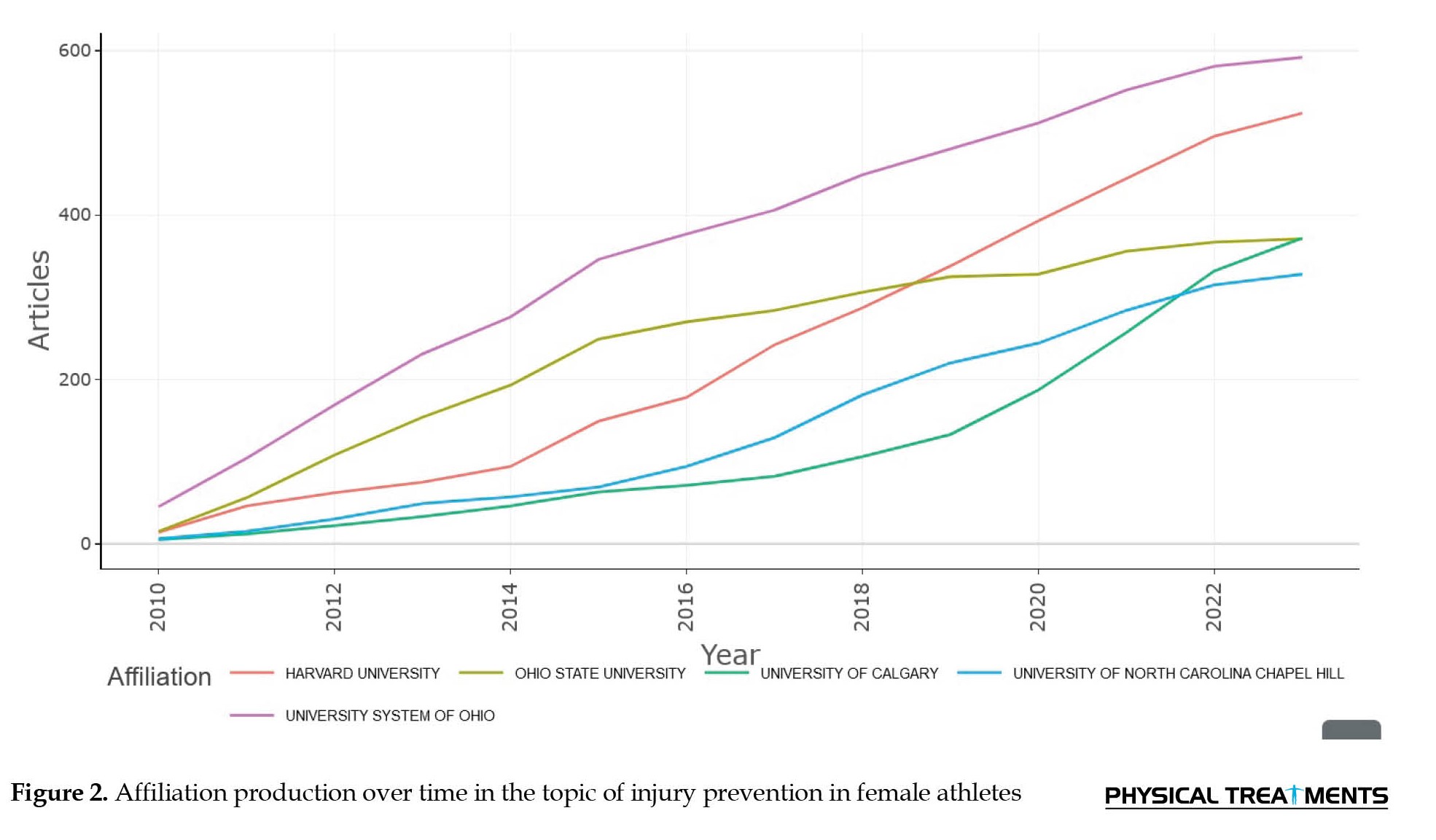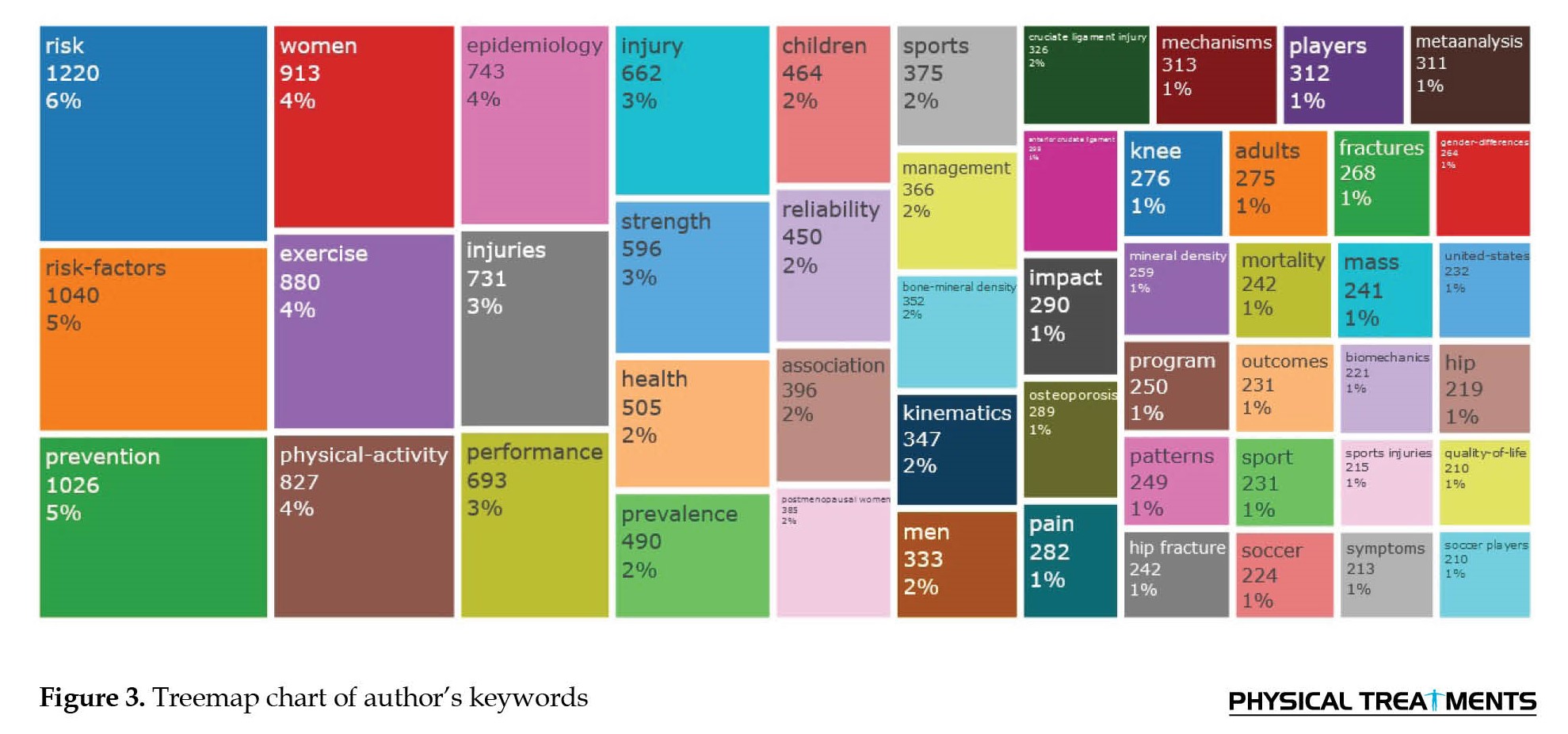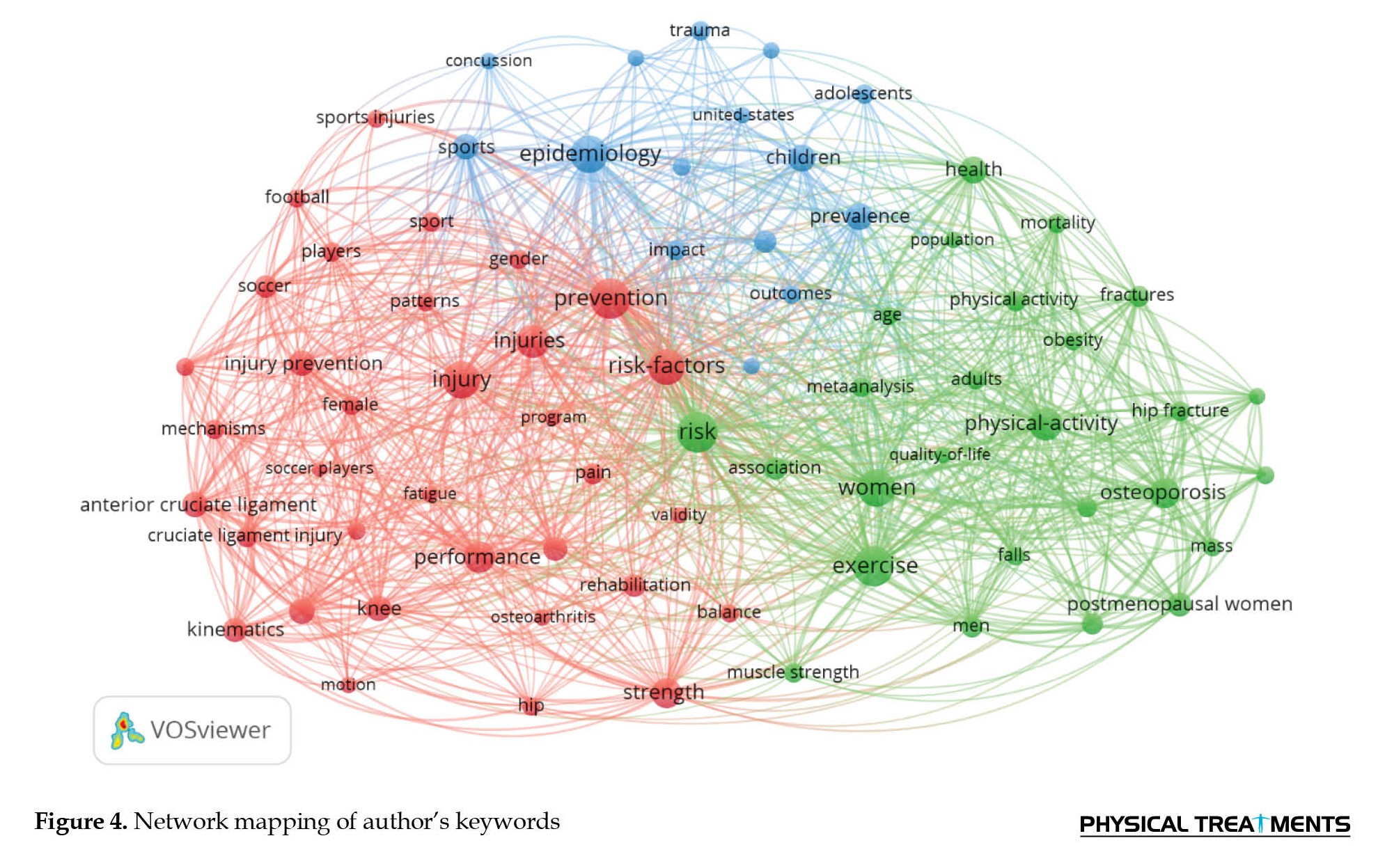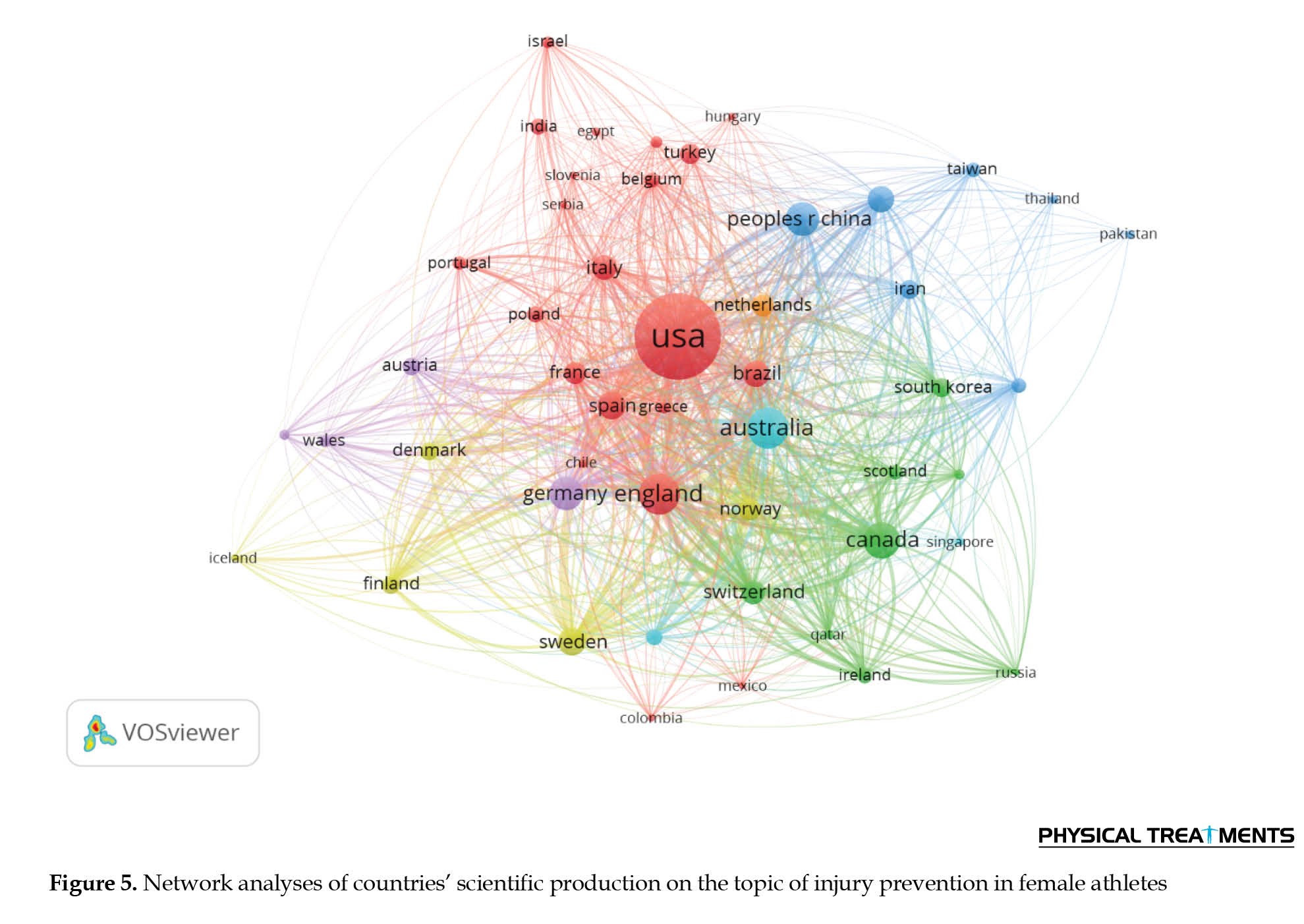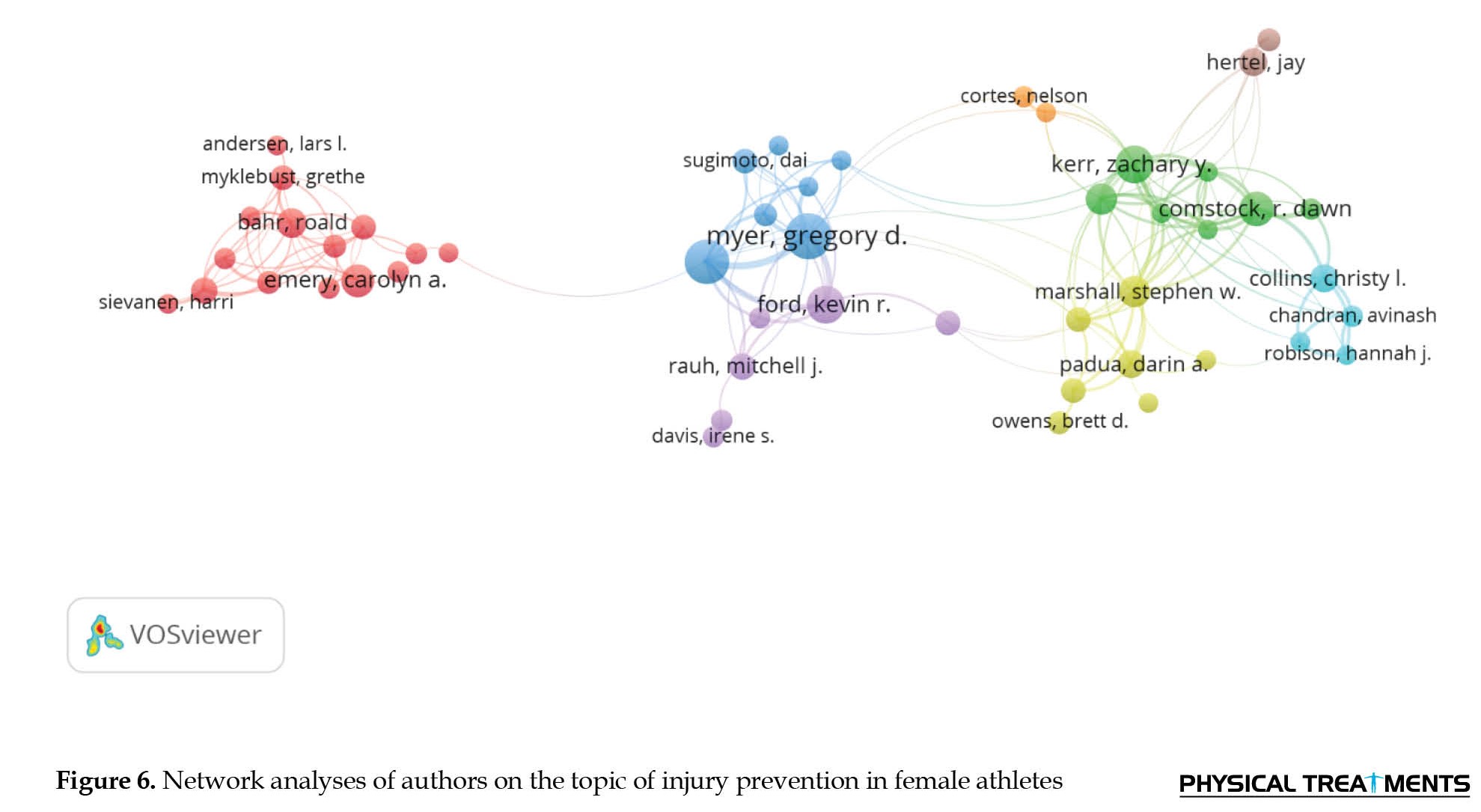Sun, Sep 21, 2025
Volume 14, Issue 1 (Winter 2024)
PTJ 2024, 14(1): 23-32 |
Back to browse issues page
Download citation:
BibTeX | RIS | EndNote | Medlars | ProCite | Reference Manager | RefWorks
Send citation to:



BibTeX | RIS | EndNote | Medlars | ProCite | Reference Manager | RefWorks
Send citation to:
Sheikhhoseini R. Injury Prevention in Female Athletes: Defining the Boundaries of Scientific Literature. PTJ 2024; 14 (1) :23-32
URL: http://ptj.uswr.ac.ir/article-1-620-en.html
URL: http://ptj.uswr.ac.ir/article-1-620-en.html
Department of Corrective Exercise & Sports Injury, Faculty of Sport Sciences, Allameh Tabataba’i University, Tehran, Iran.
Full-Text [PDF 2914 kb]
(805 Downloads)
| Abstract (HTML) (2315 Views)
Full-Text: (641 Views)
Introduction
In recent decades, there has been a 21% rise in people’s participation in organized sports, resulting in approximately 30 million young amateur athletes in the US alone [1]. This increase can be attributed to various health initiatives promoting the numerous physical and psychosocial advantages of physical activity [2]. Despite the evident benefits of engaging in sports, over 30% of injuries among the population are sports-related [3]. Risk factors, such as heightened competition levels, extended training periods, and increased intensity [4], have been consistently identified across different sporting disciplines [5], and they are considered responsible for the high injury rates. Despite advancements in research and understanding of sport-related injury mechanisms, such as anterior cruciate ligament injuries [6], and knowledge of risk factors and recovery methods, injury rates continue to remain high in athletes [7].
A sports injury is an inherent danger when engaging in sports activities. To effectively prevent injuries in athletes, it is essential to have comprehensive information on the causes and origins of these injuries [8]. Over time, various models have been developed to understand injury mechanisms and causes, contributing to the advancement of injury prevention research [9, 10, 11].
Epidemiological studies have demonstrated, that compared to males, female athletes have a significantly higher risk of sport-related injuries [12]. This increased risk, along with the rising participation of young women in sports over the last three decades (9-fold increase in high school and 5-fold increase in collegiate sports), has raised the need for research into sex-specific mechanisms and interventions to prevent sports injuries in female athletes [13, 14]. For instance, recent systematic reviews and meta-analyses have revealed that female athletes are predisposed to a higher risk of ankle sprains [15], concussions [16], and anterior cruciate ligament injuries [17]. Other meta-analyses have even demonstrated differing risks of running-related injuries between athletes’ genders [18]. Therefore, it seems that understanding the field of preventing sports injuries in female athletes is beneficial for furthering research directions and priorities in this area. This may help researchers investigate the dimensions of this topic and provide assistance in examining various aspects of the subject.
Bibliometric studies aim to examine and quantify the publishing and citation patterns among scholarly publications [19, 20]. Bibliometric studies try to evaluate the influence, impact, and trends within a particular research field or among researchers [21]. They often illustrate some metrics, such as publication count, citation count, co-authorship patterns, and journal impact factors to gain a better understanding of researchers’ productivity and visibility, as well as the contributions of institutions and scientific disciplines [21, 22]. These analyses are extensively employed in academia and research evaluation to assess the scholarly influence of individuals and institutions [22].
To our knowledge, no published paper specifically focuses on bibliometric analyses of literature related to injury prevention in female athletes. The primary objective of this analysis is to examine the growth of research publications focusing on the prevention of sports injuries among female athletes. Additionally, it aims to pinpoint the most prolific authors, institutions, and countries that have contributed to this area of research. Moreover, the study tries to explore the distribution of research topics, and investigate the citation patterns. Finally, this study aims to provide insights into collaboration networks among researchers and institutions within this domain.
Materials and Methods
This bibliometric study was conducted to summarize and evaluate scientific written papers [20, 23] in the field of injury prevention in female athletes.
Search strategy
Due to the increasing number of scientific articles, it has become essential to carefully choose appropriate keywords and a specific search approach that significantly influences the results and outcomes. To address this concern, the research employed four key elements. The search strategy for the study centered around four primary variables, “women”, “prevention”, “sport and exercise”, and “injury”. To create a robust search strategy, the study combined synonyms of these variables using quotation marks, Boolean operators, and truncation, as illustrated in Table 1.
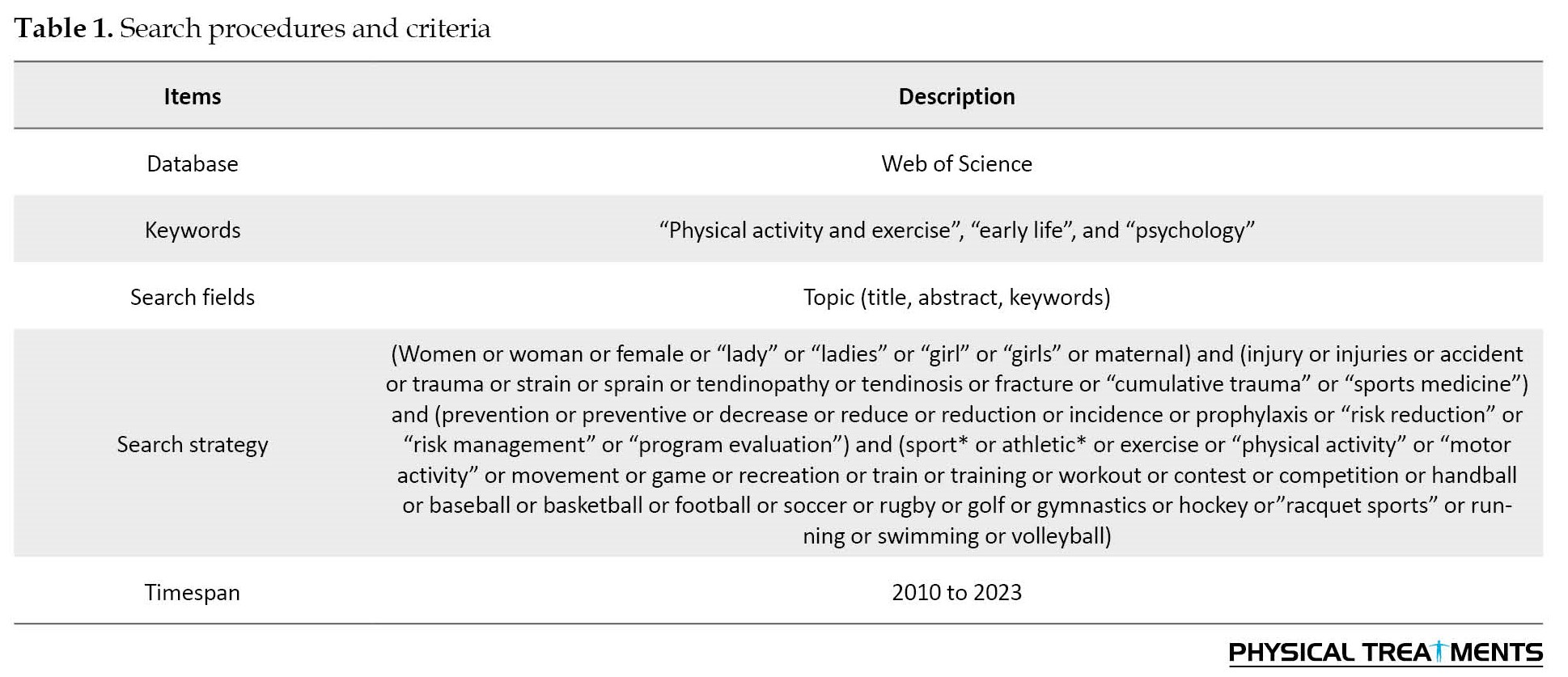
The search was confined to the topic field, including title, abstract, and keywords, within the Web of Science (WOS) database. Furthermore, the study encompassed articles in all languages and only included original articles. The resulting publications were exported in “plain text” format, comprising both the “full record and cited references”.
Data analyses
On August 1, 2023, 10 560 scientific documents were exported in “plain text” format from the WOS database. These documents covered the time frame from 2010 to 2023 and were selected based on the specified keywords. The research utilized descriptive analysis to identify the most influential authors, organizations, journals, and countries in the chosen field. Additionally, network analysis was conducted to assess co-citation, co-authorship, and co-occurrence patterns among author keywords. To generate various charts, Microsoft Excel, version 2021 was employed, while VOSviewer, version 1.6.18.0, developed by the Centre for Science and Technology Studies at Leiden University, was utilized to construct and visualize bibliometric networks among the documents. To perform the necessary network analysis, acquire structural information, and visualize the outcomes, the study utilized R language, version 4.2.2 and its RStudio Macros on a 64-bit Windows platform. The analysis process involved the utilization of the Bibliometrix R-package, version 4.0.0.
Results
Data characteristics
In this section, an overview of the searched sources is provided. These sources span from 2010 to 2023. Within the time frame covered by the WOS database, a collection of 10560 articles was published in the field, originating from 20206 distinct sources. These articles were authored by 4693 individuals. The publication growth rate during this period was calculated at 3.46% annually, and the mean age of the documents was 5.35 years. Furthermore, 249 413 references were cited across all articles, and the authors used 16 581 different keywords. Among the published articles, 252 were single-authored, and on mean, 5.65 co-authors per document existed.
Top ten relevant journals
The top ten journals in this particular field have been determined by counting the number of articles they published within the time frame of the WOS database. Leading the list is the “American journal of sports medicine” with 261 articles, followed by the “journal of athletic training” and “journal of science and medicine in sport”, both with 235 articles each. The next seven journals on the list are the “British journal of sports medicine” with 179 articles, “journal of strength and conditioning research” with 167 articles, “orthopaedic journal of sports medicine” with 157 articles, “PLOS ONE” with 153 articles, “international journal of environmental research and public health” with 145 articles, “osteoporosis international” with 143 articles, and “journal of sport rehabilitation” with 140 articles.
The most local citations
In the context of this study, “local citations” refer to the frequency with which a specific author or document within a dataset is referenced by other documents in the same dataset. According to the results, “AM J SPORT MED” obtained the highest number of local citations, with 18712 references. “BRIT J SPORT MED” closely followed with 14 861 local citations, and “Med Sci Sport Exer” ranked third with 9 630 local citations. The subsequent seven journals in the list are “J Athl Training” with 6666 local citations, “Osteoporosis Int” with 6 321 local citations, “J Bone Miner Res” with 5586 local citations, “Sports Med” with 5554 local citations, “J
Strength Cond Res” with 5329 local citations, “Scand J Med Sci Spor” with 4360 local citations, and “J Orthop Sport Phys” with 3793 local citations.
The most relevant authors
During the period covered by the WOS database, the top three authors with the highest number of published articles in this field are Myer GD with 85 articles, Hewett TE with 80 articles, and Kerr ZY with 61 articles. Following them, seven more authors exist on the list, Ford KR with 58 articles, Emery CA with 51 articles, Comstock RD with 50 articles, Bahr R with 46 articles, Dompier TP with 42 articles, Marshall SW with 42 articles, and Collins CL with 38 articles. Figure 1 illustrates the activity of these authors from 2010 to 2023. The top three authors continue to be actively involved in publishing articles in this field.
Most relevant affiliations
In this section, the number of published articles in this field for the top 10 universities and institutions during the WOS database’s covered period is presented. Leading the list is the University System of Ohio with 592 published articles, followed by Harvard University with
524 articles, and the University of Calgary with 372 articles. The following seven universities and institutions include Ohio State University with 371 articles, the University of North Carolina Chapel Hill with 328 articles, the University of North Carolina with 320 articles, the University of California System with 299 articles, the Harvard Medical School with 252 articles, and the University of Toronto with 220 articles. Figure 2 shows a consistent increase in the number of article publications from these universities since 2010.
Countries’ scientific production
When it comes to article-producing countries in this field, the United States leads the way with the highest number of published articles, involving 3357 corresponding authors. Following the United States, Australia ranks second with 630 corresponding authors, followed by China with 599 corresponding authors, and the United Kingdom with 583 authors. Canada, Germany, Japan, Spain, Sweden, and Brazil are next on the list, contributing 474, 451, 333, 306, 299, and 298 corresponding authors to articles, respectively. No representatives from the African continent exist on this list.
Keyword analysis
Figure 3 presents the highest number of keywords utilized in these articles. The size of each box represents the frequency of usage, and the percentage of each keyword’s occurrence in the total reviewed texts is indicated within each box. The most commonly utilized words in this field, listed in descending order, included risk, risk factors, prevention, woman, exercise, physical activity, epidemiology, injuries, performance, injury, strength, and health. Figure 4 illustrates a network analysis of the keywords found in these articles. This analysis demonstrates the simultaneous use of keywords within the articles. The greater the number of connecting lines between two keywords, the more frequently they have been used together in the articles.
Network analyses
Figure 5 shows the collaboration among authors from diverse countries in generating these articles. This indicates that the subject area can be considered international, drawing the interest of scientists from different nations to engage in joint research efforts. For example, the illustration reveals a significant level of collaboration between the USA and countries, such as Spain, Brazil, and the Netherlands. Figure 6 also emphasizes that authors with different affiliations have collaborated in writing these articles. This can be attributed to the interdisciplinary and multidisciplinary nature of the research topic. Figure 7 shows the collaboration between various universities in producing these articles, with the collaboration network notably evident among the top ten universities in this field.
Discussion
This research undertook a bibliometric analysis to investigate current patterns in injury prevention in female athletes. Using 10 560 scientific documents from the WOS database, we thoroughly explored the intellectual terrain of this area. The study’s outcomes provide valuable and applicable perspectives on the advancement of injury prevention among female athletes.
This paper was conducted to present a thorough examination of the progression of research on injury prevention in female athletes from 2010 to 2023. A considerable number of papers were discovered during this timeframe, demonstrating a rising interest among different journals and authors in this subject. The number of documents has exhibited an upward trend over the years, potentially influenced by the incorporation of a broader range of journals in the field and an increased demand for knowledge in this area.
The data showed a significant increase in researchers from various scientific fields participating in studies, which can reflect the interdisciplinary nature of injury prevention and female health. This trend underscores the appeal of this field to scholars from diverse disciplines who aim to explore its potential and make significant contributions to its progress. Additionally, the interdisciplinary aspect of this area presents opportunities for fruitful collaborations both at the national and international levels.
The data provided in this article identifies Gregory D. Myer, associated with Emory University School of Medicine in the USA, as the most prolific author in the chosen research field. His research primarily revolves around investigating the interrelationships among sports medicine, athletic injuries, biomechanics, sensorimotor neuroscience, and youth sports.
Moreover, the journals “American journal of sports medicine” and “journal of athletic training” have made substantial contributions to injury prevention in female athletes, publishing 261 and 235 papers, respectively. The remarkable output from these highly active and productive journals has been pivotal in advancing scientific research on injury prevention in female athletes. Undoubtedly, their contributions have facilitated significant scientific progress in this specific area of study.
Most top ten productive organizations and institutions supporting research in the field of injury prevention among female athletes are situated in the United States, with the 10th institution being the University of Toronto in Canada. The United States stands out as the country with the highest number of productive organizations compared to other developed nations. Among them, the University System of Ohio and Harvard University stand out as the top two institutions globally.
Nevertheless, it is essential to recognize that a substantial segment of the global population, particularly in developing countries, is not adequately represented in the research concerning injury prevention among female athletes. It is crucial to bridge this gap by promoting research endeavors in developing nations, particularly in regions, such as Asia and Africa. By doing so, we can attain a more comprehensive understanding of injury prevention among female athletes, resulting in more universally applicable diagnosis profiles and treatment outcomes.
The results of this study emphasize the importance of conducting further research that combines injury prevention and female athletes in developing countries. The limited research output and outcomes from these regions can be attributed to factors, such as inadequate research facilities, insufficient funding sources, and a shortage of trained personnel. To address this disparity and foster equitable research outcomes, it is essential to enhance research capabilities and support in developing countries, empowering them to make meaningful contributions to the field of injury prevention among female athletes.
The analysis of keywords revealed a distinct pattern, with a significant number of theme-related terms centered around sports, exercise, females, and injury prevention. The study delved into the intersection of injury prevention in female athletes, and key conceptual constructs encompassed terms, such as risk, risk factors, prevention, woman, exercise, physical activity, epidemiology, injuries, performance, injury, strength, and health.
Conclusion
This study conducted a comprehensive examination, analyzing prominent authors, publishing journals, productive organizations, nations, and popular keywords in the context of injury prevention combined with female athletes. The results revealed a significant and noteworthy growth in integrated research in this area over the past decade. A considerable contribution in the field of injury prevention among female athletes came from diverse authors, organizations, and journals in developed nations, such as the United States, Canada, Australia, and the Netherlands. Identifying common themes in this field has the potential to influence upcoming interdisciplinary papers. Looking ahead, future research remains highly interested in exploring injury prevention among female athletes, as it continues to be an area of great interest and importance. The insights gained from this study are expected to have a significant impact on advancing knowledge in this domain and stimulating further investigations.
This research is the first comprehensive bibliometric analysis exploring the intersection of injury prevention and female athletes. By examining the productivity of recent scientific documents, the study provides a clear understanding of the distribution of research contributions in this distinctive field. The results not only offer valuable insights into the practical applications of such research but also expand the reader’s perspective on the implications of the study.
The study has certain limitations. Firstly, it focused exclusively on articles available in the WOS database, which may not encompass all journals that have published research on injury prevention among female athletes. As a result, there may be variations in the number of citations reported. Furthermore, the study did not explore the frequency of self-citation, where authors cite their previous work to increase article citations. Investigating self-citation prevalence in this research area and its impact on article visibility and influence could be beneficial for future research. Moreover, the study’s focus on journal articles led to the exclusion of other valuable scientific literature, such as books, conference papers, and textbook chapters. For a more comprehensive understanding of the field, future research should consider incorporating a broader range of academic sources. The search and extraction of injury prevention among female athletes’ documents from the WOS database were limited to specific keywords, as described in the Methods section. Given the vast scope of this research area, future researchers should use a more diverse set of terms in their searches to capture a wider array of relevant publications.
Ethical Considerations
Compliance with ethical guidelines
This article is a bibliometric analysis with no human or animal sample.
Funding
This research did not receive any grant from funding agencies in the public, commercial, or non-profit sectors.
Conflict of interest
The author declared no conflict of interest.
References
In recent decades, there has been a 21% rise in people’s participation in organized sports, resulting in approximately 30 million young amateur athletes in the US alone [1]. This increase can be attributed to various health initiatives promoting the numerous physical and psychosocial advantages of physical activity [2]. Despite the evident benefits of engaging in sports, over 30% of injuries among the population are sports-related [3]. Risk factors, such as heightened competition levels, extended training periods, and increased intensity [4], have been consistently identified across different sporting disciplines [5], and they are considered responsible for the high injury rates. Despite advancements in research and understanding of sport-related injury mechanisms, such as anterior cruciate ligament injuries [6], and knowledge of risk factors and recovery methods, injury rates continue to remain high in athletes [7].
A sports injury is an inherent danger when engaging in sports activities. To effectively prevent injuries in athletes, it is essential to have comprehensive information on the causes and origins of these injuries [8]. Over time, various models have been developed to understand injury mechanisms and causes, contributing to the advancement of injury prevention research [9, 10, 11].
Epidemiological studies have demonstrated, that compared to males, female athletes have a significantly higher risk of sport-related injuries [12]. This increased risk, along with the rising participation of young women in sports over the last three decades (9-fold increase in high school and 5-fold increase in collegiate sports), has raised the need for research into sex-specific mechanisms and interventions to prevent sports injuries in female athletes [13, 14]. For instance, recent systematic reviews and meta-analyses have revealed that female athletes are predisposed to a higher risk of ankle sprains [15], concussions [16], and anterior cruciate ligament injuries [17]. Other meta-analyses have even demonstrated differing risks of running-related injuries between athletes’ genders [18]. Therefore, it seems that understanding the field of preventing sports injuries in female athletes is beneficial for furthering research directions and priorities in this area. This may help researchers investigate the dimensions of this topic and provide assistance in examining various aspects of the subject.
Bibliometric studies aim to examine and quantify the publishing and citation patterns among scholarly publications [19, 20]. Bibliometric studies try to evaluate the influence, impact, and trends within a particular research field or among researchers [21]. They often illustrate some metrics, such as publication count, citation count, co-authorship patterns, and journal impact factors to gain a better understanding of researchers’ productivity and visibility, as well as the contributions of institutions and scientific disciplines [21, 22]. These analyses are extensively employed in academia and research evaluation to assess the scholarly influence of individuals and institutions [22].
To our knowledge, no published paper specifically focuses on bibliometric analyses of literature related to injury prevention in female athletes. The primary objective of this analysis is to examine the growth of research publications focusing on the prevention of sports injuries among female athletes. Additionally, it aims to pinpoint the most prolific authors, institutions, and countries that have contributed to this area of research. Moreover, the study tries to explore the distribution of research topics, and investigate the citation patterns. Finally, this study aims to provide insights into collaboration networks among researchers and institutions within this domain.
Materials and Methods
This bibliometric study was conducted to summarize and evaluate scientific written papers [20, 23] in the field of injury prevention in female athletes.
Search strategy
Due to the increasing number of scientific articles, it has become essential to carefully choose appropriate keywords and a specific search approach that significantly influences the results and outcomes. To address this concern, the research employed four key elements. The search strategy for the study centered around four primary variables, “women”, “prevention”, “sport and exercise”, and “injury”. To create a robust search strategy, the study combined synonyms of these variables using quotation marks, Boolean operators, and truncation, as illustrated in Table 1.

The search was confined to the topic field, including title, abstract, and keywords, within the Web of Science (WOS) database. Furthermore, the study encompassed articles in all languages and only included original articles. The resulting publications were exported in “plain text” format, comprising both the “full record and cited references”.
Data analyses
On August 1, 2023, 10 560 scientific documents were exported in “plain text” format from the WOS database. These documents covered the time frame from 2010 to 2023 and were selected based on the specified keywords. The research utilized descriptive analysis to identify the most influential authors, organizations, journals, and countries in the chosen field. Additionally, network analysis was conducted to assess co-citation, co-authorship, and co-occurrence patterns among author keywords. To generate various charts, Microsoft Excel, version 2021 was employed, while VOSviewer, version 1.6.18.0, developed by the Centre for Science and Technology Studies at Leiden University, was utilized to construct and visualize bibliometric networks among the documents. To perform the necessary network analysis, acquire structural information, and visualize the outcomes, the study utilized R language, version 4.2.2 and its RStudio Macros on a 64-bit Windows platform. The analysis process involved the utilization of the Bibliometrix R-package, version 4.0.0.
Results
Data characteristics
In this section, an overview of the searched sources is provided. These sources span from 2010 to 2023. Within the time frame covered by the WOS database, a collection of 10560 articles was published in the field, originating from 20206 distinct sources. These articles were authored by 4693 individuals. The publication growth rate during this period was calculated at 3.46% annually, and the mean age of the documents was 5.35 years. Furthermore, 249 413 references were cited across all articles, and the authors used 16 581 different keywords. Among the published articles, 252 were single-authored, and on mean, 5.65 co-authors per document existed.
Top ten relevant journals
The top ten journals in this particular field have been determined by counting the number of articles they published within the time frame of the WOS database. Leading the list is the “American journal of sports medicine” with 261 articles, followed by the “journal of athletic training” and “journal of science and medicine in sport”, both with 235 articles each. The next seven journals on the list are the “British journal of sports medicine” with 179 articles, “journal of strength and conditioning research” with 167 articles, “orthopaedic journal of sports medicine” with 157 articles, “PLOS ONE” with 153 articles, “international journal of environmental research and public health” with 145 articles, “osteoporosis international” with 143 articles, and “journal of sport rehabilitation” with 140 articles.
The most local citations
In the context of this study, “local citations” refer to the frequency with which a specific author or document within a dataset is referenced by other documents in the same dataset. According to the results, “AM J SPORT MED” obtained the highest number of local citations, with 18712 references. “BRIT J SPORT MED” closely followed with 14 861 local citations, and “Med Sci Sport Exer” ranked third with 9 630 local citations. The subsequent seven journals in the list are “J Athl Training” with 6666 local citations, “Osteoporosis Int” with 6 321 local citations, “J Bone Miner Res” with 5586 local citations, “Sports Med” with 5554 local citations, “J
Strength Cond Res” with 5329 local citations, “Scand J Med Sci Spor” with 4360 local citations, and “J Orthop Sport Phys” with 3793 local citations.
The most relevant authors
During the period covered by the WOS database, the top three authors with the highest number of published articles in this field are Myer GD with 85 articles, Hewett TE with 80 articles, and Kerr ZY with 61 articles. Following them, seven more authors exist on the list, Ford KR with 58 articles, Emery CA with 51 articles, Comstock RD with 50 articles, Bahr R with 46 articles, Dompier TP with 42 articles, Marshall SW with 42 articles, and Collins CL with 38 articles. Figure 1 illustrates the activity of these authors from 2010 to 2023. The top three authors continue to be actively involved in publishing articles in this field.
Most relevant affiliations
In this section, the number of published articles in this field for the top 10 universities and institutions during the WOS database’s covered period is presented. Leading the list is the University System of Ohio with 592 published articles, followed by Harvard University with
524 articles, and the University of Calgary with 372 articles. The following seven universities and institutions include Ohio State University with 371 articles, the University of North Carolina Chapel Hill with 328 articles, the University of North Carolina with 320 articles, the University of California System with 299 articles, the Harvard Medical School with 252 articles, and the University of Toronto with 220 articles. Figure 2 shows a consistent increase in the number of article publications from these universities since 2010.
Countries’ scientific production
When it comes to article-producing countries in this field, the United States leads the way with the highest number of published articles, involving 3357 corresponding authors. Following the United States, Australia ranks second with 630 corresponding authors, followed by China with 599 corresponding authors, and the United Kingdom with 583 authors. Canada, Germany, Japan, Spain, Sweden, and Brazil are next on the list, contributing 474, 451, 333, 306, 299, and 298 corresponding authors to articles, respectively. No representatives from the African continent exist on this list.
Keyword analysis
Figure 3 presents the highest number of keywords utilized in these articles. The size of each box represents the frequency of usage, and the percentage of each keyword’s occurrence in the total reviewed texts is indicated within each box. The most commonly utilized words in this field, listed in descending order, included risk, risk factors, prevention, woman, exercise, physical activity, epidemiology, injuries, performance, injury, strength, and health. Figure 4 illustrates a network analysis of the keywords found in these articles. This analysis demonstrates the simultaneous use of keywords within the articles. The greater the number of connecting lines between two keywords, the more frequently they have been used together in the articles.
Network analyses
Figure 5 shows the collaboration among authors from diverse countries in generating these articles. This indicates that the subject area can be considered international, drawing the interest of scientists from different nations to engage in joint research efforts. For example, the illustration reveals a significant level of collaboration between the USA and countries, such as Spain, Brazil, and the Netherlands. Figure 6 also emphasizes that authors with different affiliations have collaborated in writing these articles. This can be attributed to the interdisciplinary and multidisciplinary nature of the research topic. Figure 7 shows the collaboration between various universities in producing these articles, with the collaboration network notably evident among the top ten universities in this field.
Discussion
This research undertook a bibliometric analysis to investigate current patterns in injury prevention in female athletes. Using 10 560 scientific documents from the WOS database, we thoroughly explored the intellectual terrain of this area. The study’s outcomes provide valuable and applicable perspectives on the advancement of injury prevention among female athletes.
This paper was conducted to present a thorough examination of the progression of research on injury prevention in female athletes from 2010 to 2023. A considerable number of papers were discovered during this timeframe, demonstrating a rising interest among different journals and authors in this subject. The number of documents has exhibited an upward trend over the years, potentially influenced by the incorporation of a broader range of journals in the field and an increased demand for knowledge in this area.
The data showed a significant increase in researchers from various scientific fields participating in studies, which can reflect the interdisciplinary nature of injury prevention and female health. This trend underscores the appeal of this field to scholars from diverse disciplines who aim to explore its potential and make significant contributions to its progress. Additionally, the interdisciplinary aspect of this area presents opportunities for fruitful collaborations both at the national and international levels.
The data provided in this article identifies Gregory D. Myer, associated with Emory University School of Medicine in the USA, as the most prolific author in the chosen research field. His research primarily revolves around investigating the interrelationships among sports medicine, athletic injuries, biomechanics, sensorimotor neuroscience, and youth sports.
Moreover, the journals “American journal of sports medicine” and “journal of athletic training” have made substantial contributions to injury prevention in female athletes, publishing 261 and 235 papers, respectively. The remarkable output from these highly active and productive journals has been pivotal in advancing scientific research on injury prevention in female athletes. Undoubtedly, their contributions have facilitated significant scientific progress in this specific area of study.
Most top ten productive organizations and institutions supporting research in the field of injury prevention among female athletes are situated in the United States, with the 10th institution being the University of Toronto in Canada. The United States stands out as the country with the highest number of productive organizations compared to other developed nations. Among them, the University System of Ohio and Harvard University stand out as the top two institutions globally.
Nevertheless, it is essential to recognize that a substantial segment of the global population, particularly in developing countries, is not adequately represented in the research concerning injury prevention among female athletes. It is crucial to bridge this gap by promoting research endeavors in developing nations, particularly in regions, such as Asia and Africa. By doing so, we can attain a more comprehensive understanding of injury prevention among female athletes, resulting in more universally applicable diagnosis profiles and treatment outcomes.
The results of this study emphasize the importance of conducting further research that combines injury prevention and female athletes in developing countries. The limited research output and outcomes from these regions can be attributed to factors, such as inadequate research facilities, insufficient funding sources, and a shortage of trained personnel. To address this disparity and foster equitable research outcomes, it is essential to enhance research capabilities and support in developing countries, empowering them to make meaningful contributions to the field of injury prevention among female athletes.
The analysis of keywords revealed a distinct pattern, with a significant number of theme-related terms centered around sports, exercise, females, and injury prevention. The study delved into the intersection of injury prevention in female athletes, and key conceptual constructs encompassed terms, such as risk, risk factors, prevention, woman, exercise, physical activity, epidemiology, injuries, performance, injury, strength, and health.
Conclusion
This study conducted a comprehensive examination, analyzing prominent authors, publishing journals, productive organizations, nations, and popular keywords in the context of injury prevention combined with female athletes. The results revealed a significant and noteworthy growth in integrated research in this area over the past decade. A considerable contribution in the field of injury prevention among female athletes came from diverse authors, organizations, and journals in developed nations, such as the United States, Canada, Australia, and the Netherlands. Identifying common themes in this field has the potential to influence upcoming interdisciplinary papers. Looking ahead, future research remains highly interested in exploring injury prevention among female athletes, as it continues to be an area of great interest and importance. The insights gained from this study are expected to have a significant impact on advancing knowledge in this domain and stimulating further investigations.
This research is the first comprehensive bibliometric analysis exploring the intersection of injury prevention and female athletes. By examining the productivity of recent scientific documents, the study provides a clear understanding of the distribution of research contributions in this distinctive field. The results not only offer valuable insights into the practical applications of such research but also expand the reader’s perspective on the implications of the study.
The study has certain limitations. Firstly, it focused exclusively on articles available in the WOS database, which may not encompass all journals that have published research on injury prevention among female athletes. As a result, there may be variations in the number of citations reported. Furthermore, the study did not explore the frequency of self-citation, where authors cite their previous work to increase article citations. Investigating self-citation prevalence in this research area and its impact on article visibility and influence could be beneficial for future research. Moreover, the study’s focus on journal articles led to the exclusion of other valuable scientific literature, such as books, conference papers, and textbook chapters. For a more comprehensive understanding of the field, future research should consider incorporating a broader range of academic sources. The search and extraction of injury prevention among female athletes’ documents from the WOS database were limited to specific keywords, as described in the Methods section. Given the vast scope of this research area, future researchers should use a more diverse set of terms in their searches to capture a wider array of relevant publications.
Ethical Considerations
Compliance with ethical guidelines
This article is a bibliometric analysis with no human or animal sample.
Funding
This research did not receive any grant from funding agencies in the public, commercial, or non-profit sectors.
Conflict of interest
The author declared no conflict of interest.
References
- Barber Foss KD, Myer GD, Hewett TE. Epidemiology of basketball, soccer, and volleyball injuries in middle-school female athletes. The Physician and Sportsmedicine. 2014; 42(2):146-53. [DOI:10.3810/psm.2014.05.2066] [PMID]
- Eigenschenk B, Thomann A, McClure M, Davies L, Gregory M, Dettweiler U, et al. Benefits of outdoor sports for society. A systematic literature review and reflections on evidence. International Journal of Environmental Research and Public Health. 2019; 16(6):937. [DOI:10.3390/ijerph16060937] [PMID]
- Pickett W, Molcho M, Simpson K, Janssen I, Kuntsche E, Mazur J, et al. Cross national study of injury and social determinants in adolescents. Injury Prevention. : Journal of the International Society for Child and Adolescent Injury Prevention. 2005; 11(4):213-8. [DOI:10.1136/ip.2004.007021] [PMID]
- Kalkhoven JT, Watsford ML, Impellizzeri FM. A conceptual model and detailed framework for stress-related, strain-related, and overuse athletic injury. Journal of Science and Medicine in Sport. 2020; 23(8):726-34. [DOI:10.1016/j.jsams.2020.02.002] [PMID]
- Ceyssens L, Vanelderen R, Barton C, Malliaras P, Dingenen B. Biomechanical risk factors associated with running-related injuries: A systematic review. Sports Medicine. 2019; 49(7):1095-115. [DOI:10.1007/s40279-019-01110-z] [PMID]
- Huang YL, Jung J, Mulligan CMS, Oh J, Norcross MF. A majority of anterior cruciate ligament injuries can be prevented by injury prevention programs: A systematic review of randomized controlled trials and cluster-randomized controlled trials with meta-analysis. The American Journal of Sports Medicine. 2020; 48(6):1505-15. [DOI:10.1177/0363546519870175] [PMID]
- Herzog MM, Kerr ZY, Marshall SW, Wikstrom EA. Epidemiology of ankle sprains and chronic ankle instability. Journal of Athletic Training. 2019; 54(6):603-10. [DOI:10.4085/1062-6050-447-17] [PMID]
- Farley JB, Barrett LM, Keogh JWL, Woods CT, Milne N. The relationship between physical fitness attributes and sports injury in female, team ball sport players: A systematic review. Sports Medicine - Open. 2020; 6(1):45. [DOI:10.1186/s40798-020-00264-9] [PMID]
- Sañudo B, Sánchez-Hernández J, Bernardo-Filho M, Abdi E, Taiar R, Núñez J. Integrative neuromuscular training in young athletes, injury prevention, and performance optimization: A systematic review. Applied Sciences. 2019; 9(18):3839. [DOI:10.3390/app9183839]
- Plummer A, Mugele H, Steffen K, Stoll J, Mayer F, Müller J. General versus sports-specific injury prevention programs in athletes: A systematic review on the effects on performance. Plos One. 2019; 14(8):e0221346. [DOI:10.1371/journal.pone.0221346] [PMID]
- Hanlon C, Krzak JJ, Prodoehl J, Hall KD. Effect of injury prevention programs on lower extremity performance in youth athletes: A systematic review. Sports Health. 2020; 12(1):12-22. [DOI:10.1177/1941738119861117] [PMID]
- Abbott A, Bird ML, Wild E, Brown SM, Stewart G, Mulcahey MK. Part I: Epidemiology and risk factors for stress fractures in female athletes. The Physician and Sportsmedicine. 2020; 48(1):17-24. [DOI:10.1080/00913847.2019.1632158] [PMID]
- Zech A, Hollander K, Junge A, Steib S, Groll A, Heiner J, et al. Sex differences in injury rates in team-sport athletes: A systematic review and meta-regression analysis. Journal of Sport and Health Science. 2022; 11(1):104-14. [DOI:10.1016/j.jshs.2021.04.003] [PMID]
- Fallahi Farrash F, Sheikhhoseini R, Babakhani F. Effect of 8 weeks of functional exercise on soft surfaces on balance and electromyographic activity of selected muscles in female taekwondo athletes. Women’s Health Bulletin. 2020; 7(2):19-25. [DOI:10.30476/whb.2020.85795.1047]
- Doherty C, Delahunt E, Caulfield B, Hertel J, Ryan J, Bleakley C. The Incidence and Prevalence of ankle sprain injury: A systematic review and meta-analysis of prospective epidemiological studies. Sports Medicine. 2014; 44(1):123-40. [DOI:10.1007/s40279-013-0102-5] [PMID]
- Prien A, Grafe A, Rössler R, Junge A, Verhagen E. Epidemiology of head injuries focusing on concussions in team contact sports: A systematic review. Sports Medicine. 2018; 48(4):953-69. [DOI:10.1007/s40279-017-0854-4] [PMID]
- Montalvo AM, Schneider DK, Yut L, Webster KE, Beynnon B, Kocher MS, et al. “What’s my risk of sustaining an ACL injury while playing sports?” A systematic review with meta-analysis. British Journal of Sports Medicine. 2019; 53(16):1003-12. [DOI:10.1136/bjsports-2016-096274] [PMID]
- Hollander K, Rahlf AL, Wilke J, Edler C, Steib S, Junge A, et al. Sex-specific differences in running injuries: A systematic review with meta-analysis and meta-regression. Sports Medicine. 2021; 51(5):1011-39. [DOI:10.1007/s40279-020-01412-7] [PMID]
- Hyland K, Jiang F. A bibliometric study of EAP research: Who is doing what, where and when? Journal of English for Academic Purposes. 2021; 49:100929. [DOI:10.1016/j.jeap.2020.100929]
- Donthu N, Kumar S, Mukherjee D, Pandey N, Lim WM. How to conduct a bibliometric analysis: An overview and guidelines. Journal of Business Research. 2021; 133:285-96. [DOI:10.1016/j.jbusres.2021.04.070]
- Romanelli JP, Gonçalves MCP, de Abreu Pestana LF, Soares JAH, Boschi RS, Andrade DF. Four challenges when conducting bibliometric reviews and how to deal with them. Environmental Science and Pollution Research. 2021; 28(43):60448-58. [DOI:10.1007/s11356-021-16420-x] [PMID]
- Ellegaard O, Wallin JA. The bibliometric analysis of scholarly production: How great is the impact? Scientometrics. 2015; 105(3):1809-31. [DOI:10.1007/s11192-015-1645-z] [PMID]
- Danvila-del-Valle I, Estévez-Mendoza C, Lara FJ. Human resources training: A bibliometric analysis. Journal of Business Research. 2019; 101:627-36. [DOI:10.1016/j.jbusres.2019.02.026]
Type of Study: Research |
Subject:
General
Received: 2023/12/10 | Accepted: 2023/12/29 | Published: 2024/01/1
Received: 2023/12/10 | Accepted: 2023/12/29 | Published: 2024/01/1
Send email to the article author
| Rights and permissions | |
 |
This work is licensed under a Creative Commons Attribution-NonCommercial 4.0 International License. |
